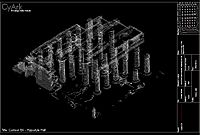Hypostyle facts for kids

A hypostyle hall is a large room with a flat roof. This roof is held up by many tall columns. Imagine a big hall where columns are everywhere, supporting the ceiling above. The word "hypostyle" comes from ancient Greek and means "under columns."
These halls were very popular in ancient times. They allowed builders to create huge indoor spaces. Without columns, it would be much harder to support such a large roof.
Contents
What is a Hypostyle Hall?
A hypostyle hall is a special type of building design. It features a roof that rests on many columns. These columns are usually arranged in rows. This design creates a large, open space inside. It also helps to support the heavy roof.
The columns are often placed close together. This makes the hall feel grand and impressive. It also helps to keep the building cool in hot climates. The many columns can create shadows and block direct sunlight.
Ancient Egyptian Hypostyle Halls
One of the most famous places to see hypostyle halls is in Ancient Egypt. Many ancient Egyptian temples had these halls. They were often used as prayer halls or main gathering areas.
Karnak Temple's Great Hall
The Temple of Karnak has one of the largest hypostyle halls ever built. It is called the Great Hypostyle Hall. This hall has 134 massive columns! Some of these columns are over 20 meters (66 feet) tall. They are decorated with carvings and hieroglyphs. This hall was built over many years by different pharaohs. It was a very important part of the temple complex.
Ramesseum and Other Temples
Another famous example is at the Ramesseum. This is the memorial temple of Pharaoh Ramesses II. Its hypostyle hall also features many columns. These halls were not just for support. They also created a sense of awe and mystery. The columns often represented papyrus plants or lotus flowers. This connected the temple to nature and the gods.
Hypostyle Halls in Mosques
Hypostyle halls were also important in Islamic architecture. Many early mosques used this design. They provided large prayer spaces for many people.
Great Mosque of Kairouan
A great example is the Great Mosque of Kairouan in Tunisia. Its prayer hall is a hypostyle hall. It has many columns supporting the roof. This design allowed for a large, open space. It was perfect for the many worshippers who gathered there. The columns often came from older Roman or Byzantine buildings. This was a common practice in early Islamic architecture.
Why Were They Built?
Hypostyle halls were built for several reasons:
- Support: They provided strong support for heavy roofs. This allowed for very large buildings.
- Space: They created vast indoor areas. These spaces could hold many people for ceremonies or prayers.
- Coolness: In hot climates, the many columns created shade. This helped to keep the interior cool.
- Symbolism: In temples, the columns often had religious meanings. They could represent forests or sacred groves.
Images for kids
-
The central columns of the amazing Great Hypostyle Hall in the Temple of Karnak in Egypt.
See also
 In Spanish: Sala hipóstila para niños
In Spanish: Sala hipóstila para niños



